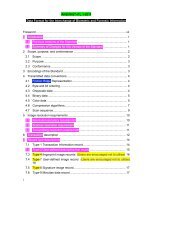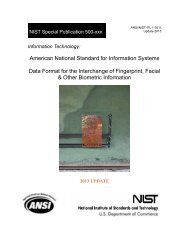ANSI/NIST Standard Update
ANSI/NIST Standard Update
ANSI/NIST Standard Update
- No tags were found...
You also want an ePaper? Increase the reach of your titles
YUMPU automatically turns print PDFs into web optimized ePapers that Google loves.
<strong>ANSI</strong>/<strong>NIST</strong> <strong>Standard</strong> <strong>Update</strong>Brad WingNational Institute of <strong>Standard</strong>s and Technology
Locations of systems with the <strong>ANSI</strong>/<strong>NIST</strong>-ITLstandard installed for data transfer(known to <strong>NIST</strong>)Blue: National and International System UseRed: State / Provincial / Local System Use
The Existing <strong>ANSI</strong>/<strong>NIST</strong>-ITL <strong>Standard</strong>• 1986, 1993, 1997 versions obsolete• 2000 version (Traditional format) still used insome applications: fingerprints & palm prints(images and minutiae), face images, scarmark-tattooimages• 2007 version (Traditional format) added irisand some new fingerprint minutiae fields• 2008 version (XML format) – same content as2007 version
<strong>ANSI</strong>/<strong>NIST</strong>-ITL 1-2011• Forensics:– Latent friction ridge print Extended Feature Setmarkups• cores, deltas, distinctive characteristics, minutiae, dots,incipient ridges, creases & linear distortions, ridge edgefeatures, pores & ridge edge– Universal latent workstation automated annotation– Images of the body (beyond face, iris and frictionridges)– 3D anthropomorphic facial image markup fields
New projects in <strong>ANSI</strong>/<strong>NIST</strong>-ITLfor later addition to the standard• Voice Biometrics• Dental Forensics• Conformance Testing
Voice• Working Group chaired by Alvin Martin of<strong>NIST</strong>• First Draft of proposed Record Layout beingreviewed by Working Group• Goal is to create Record Type 11 as asupplement to <strong>ANSI</strong>/<strong>NIST</strong>-ITL 1-2011• For more information, listen to the talkpresented by Mark Przybocki immediatelyfollowing this presentation
Dental ForensicsSlide 1• Used to identify bodies– Disaster Victim Identification– Murder Victims / Missing Persons• Several Techniques– Ante mortem / postmortem x-ray comparison– Analysis of pictures (with smiles showing theupper teeth)– Bite marks / molds of the teeth
Dental ForensicsSlide 2• Need to transmit information in a standardway that is understood by odontologists• American Dental Association developed theForensic Dental Data Set (<strong>ANSI</strong>/ADA 1058)• Scientific Working Group for Disaster VictimIdentification is developing guidelines forhandling bodies at disaster scenes• INTERPOL has a working group
Dental ForensicsSlide 3• <strong>ANSI</strong>/<strong>NIST</strong>-ITL Working Group bringingtogether specialists• Meeting Scheduled to coincide with theFebruary meeting of the American Academyof Forensic Science• Membership open to all interested parties• Goal is to create a new record type forinclusion in <strong>ANSI</strong>/<strong>NIST</strong>-ITL (Record Type-12)
Conformance to <strong>ANSI</strong>/<strong>NIST</strong>-ITL• Covered by Presentation by Fernando Podioand Dylan Yaga on Tuesday• Working Group established and initial testassertion list consturcted for selected RecordTypes.• Goal: Incorporate as a supplemental Annex in<strong>ANSI</strong>/<strong>NIST</strong>-ITL 1-2011
Contact Information• Brad Wing(301) 975 5663Brad.Wing@<strong>NIST</strong>.GOV<strong>Standard</strong> Homepage:http://www.nist.gov/itl/iad/ig/ansi_standard.cfm
















